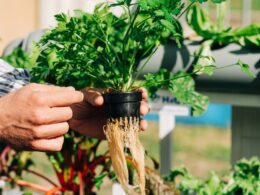Are you interested in growing your own lettuce hydroponically? Hydroponics is a great way to grow plants without the use of soil, and lettuce is a popular crop to grow this way. But how long does it take for lettuce to grow hydroponically?
The answer to this question depends on several factors, such as the type of lettuce you are growing, the conditions in which it is growing, and how long it takes for the seed to germinate and mature. Understanding these factors can help you plan your hydroponic lettuce garden and ensure a successful harvest.
In this article, we will explore the different factors that affect lettuce growth in hydroponics and provide you with the information you need to grow your own delicious lettuce at home.
Factors that Affect Lettuce Growth in Hydroponics
Discover the key factors that impact the thriving growth of your hydroponic lettuce! To ensure the best results, it’s essential to maintain the proper pH balance and nutrient levels in your hydroponic system.
The ideal pH range for lettuce is between 5.5 and 6.5, and it’s crucial to monitor and adjust pH levels regularly. Nutrient levels must also be taken into consideration, with adequate amounts of nitrogen, phosphorus, and potassium being essential for healthy growth.
The hydroponic system setup and maintenance are also critical factors that affect lettuce growth. Your hydroponic system must be appropriately set up to ensure that your plants receive the right amount of water, nutrients, and oxygen.
Regular maintenance, such as cleaning the system and checking for clogs or leaks, is also crucial to ensure that your plants are thriving. Additionally, it’s essential to monitor the temperature and lighting in your hydroponic setup to ensure optimal growing conditions.
By paying attention to these key factors, you can ensure that your hydroponic lettuce grows healthy and strong. Proper pH balance and nutrient levels, along with proper hydroponic system setup and maintenance, will help you achieve the best results.
Remember to regularly monitor and adjust as needed, and your hydroponic lettuce will thrive!
Germination and Sprouting
Now that you’ve got your seeds planted and watered, you’ll soon start to see tiny sprouts popping up through the soil! Hydroponic lettuce germination can take anywhere from a few days to a couple of weeks, depending on the variety of lettuce and the sprouting techniques used.
When sprouting lettuce seeds, it’s important to keep the environment moist and warm, so that the seeds can germinate properly. To ensure successful germination, it’s recommended that you soak your lettuce seeds in water for at least 12 hours before planting them. This will help to soften the seed coat and speed up the germination process.
Once you’ve planted your seeds, make sure to keep the environment between 65-75°F and maintain a pH level of 5.5-6.5. There are a number of sprouting techniques you can use, including tray sprouting or using a hydroponic starter kit.
Once the seeds have sprouted, you can start to gradually reduce the moisture levels and increase the light levels. This will help to promote the growth of healthy, strong lettuce plants. Remember to keep an eye on the temperature and humidity levels, as these can affect the growth rate of your lettuce.
With the right sprouting techniques and a little bit of patience, you’ll have a healthy crop of hydroponic lettuce in no time!
What Other Plants Can Grow Quickly in Hydroponics?
The world of hydroponics offers a diverse range of options for growing plants at an accelerated pace. When it comes to the fastest growing hydroponic crops, lettuce and spinach take the lead. These leafy greens thrive in hydroponic environments and can be harvested within a few weeks. Additionally, herbs like basil and cilantro are known for their quick growth in hydroponics, making them popular choices among growers. With the right setup and care, you can witness rapid growth and bountiful harvests of these crops in your hydroponic system.
Time to Maturity
You’ll be pleasantly surprised at how quickly your lettuce reaches maturity when grown using hydroponic techniques. While traditional soil-grown lettuce can take up to 60 days to mature, hydroponically grown lettuce can reach maturity in just 30 days.
This is because hydroponics allows for greater control over the factors affecting lettuce yield, such as nutrient levels, light exposure, and temperature. To optimize the growth rate of your hydroponic lettuce, there are a few key factors to consider.
First, ensure that your nutrient solution is well-balanced and contains all the necessary nutrients for healthy growth. Second, provide your plants with adequate light, as lettuce requires at least 12 hours of light per day to grow properly. Finally, maintain a consistent temperature and humidity level, as fluctuations in either can stress your plants and hinder growth.
By following these guidelines, you can expect to have fresh, crisp lettuce ready for harvest in just 30 days. And the best part? Because hydroponic systems use no soil, there is less risk of pests and diseases, making for a safer and more reliable crop. So why not give hydroponic lettuce growing a try and see the benefits for yourself?
Temperature and Lighting
Growing lettuce using hydroponics requires careful management of temperature and lighting to achieve optimal results.
Optimal conditions for lettuce growth are between 60-70°F during the day and 55-65°F at night. If the temperature is too high, lettuce may bolt and become bitter. If the temperature is too low, growth may slow down or stop altogether. It’s important to monitor the temperature regularly and adjust accordingly.
In addition to temperature, lighting is also crucial for lettuce growth. Lettuce requires at least 12-16 hours of light per day to grow properly. If the lighting is too low, the lettuce may become leggy and weak. If the lighting is too high, it may cause the lettuce to wilt or burn.
Troubleshooting tips for lighting include adjusting the distance between the light source and the plants, using reflective surfaces to maximize light, and ensuring that the light source is evenly distributed.
Overall, maintaining optimal conditions for temperature and lighting is key to growing healthy and delicious lettuce using hydroponics. By monitoring the temperature and lighting regularly and making adjustments as needed, you can ensure that your lettuce grows to its full potential.
Remember to troubleshoot any issues that arise and don’t be afraid to experiment with different lighting and temperature settings to find what works best for your specific setup.
Harvesting Your Hydroponic Lettuce
When it comes to harvesting your hydroponic lettuce, there are a few key things to keep in mind.
First, you’ll want to make sure you’re harvesting at the right time – generally, lettuce is ready to be harvested when it has reached full size and looks healthy.
Additionally, it’s important to use proper harvesting techniques to ensure that you don’t damage the plant or introduce any contaminants.
When to Harvest Lettuce
Ready to enjoy a crisp and fresh harvest from your hydroponic lettuce garden? Here’s how to know when it’s time to pick!
Firstly, keep in mind the variety of lettuce you’re growing. Some varieties, such as butterhead, looseleaf, and romaine, can be harvested when the leaves are young and tender. On the other hand, others like iceberg need to mature fully before they’re ready to be picked.
When harvesting your lettuce, it’s important to use proper harvesting tips to ensure a successful harvest. Use a clean and sharp pair of scissors or garden shears to cut the leaves off at the base. Don’t pull the leaves off, as this can damage the plant and reduce future yields.
Harvest only the outer leaves of the plant, leaving the inner leaves to continue growing and producing. By harvesting your lettuce in this manner, you’ll be able to enjoy multiple harvests from the same plant, prolonging the growing season and maximizing your yield.
Proper Harvesting Techniques
It’s important to use proper harvesting techniques when picking your hydroponic lettuce, to ensure a successful and sustainable yield. Here are some tips to help you harvest your lettuce like a pro:
- Timing is everything. Harvest your lettuce when it reaches full maturity, which is usually around 6-8 weeks after planting.
- Look for leaves that are large, crisp, and vibrant in color.
- Use sharp scissors or garden shears to snip the leaves off at the base of the stem. Avoid pulling or tearing the leaves, as this can damage the plant and reduce future yields.
- Store your freshly harvested lettuce in a sealed plastic bag or container in the refrigerator. This will help to preserve its freshness and flavor for up to a week.
By following these simple tips, you can enjoy the full flavor and nutritional benefits of your hydroponic lettuce for weeks to come.
Frequently Asked Questions
What are the advantages of growing lettuce hydroponically compared to traditional soil-based methods?
Growing lettuce hydroponically offers several advantages over traditional soil-based methods. Firstly, it’s cost-efficient as it requires less water, nutrients, and space compared to soil-based systems.
Secondly, it’s highly scalable, meaning that you can easily increase or decrease production based on demand.
Additionally, hydroponic systems are less susceptible to pests and diseases, reducing the need for harmful pesticides and herbicides. This makes it a safer option for both the grower and the consumer.
Overall, if you’re looking for a sustainable, efficient, and safe way to grow lettuce, hydroponics is definitely worth considering.
How much water and nutrients does hydroponic lettuce require compared to soil-grown lettuce?
To grow hydroponic lettuce successfully, it’s crucial to understand the water and nutrient requirements that come with this method of cultivation. Hydroponic lettuce farming requires a precise balance of nutrients, oxygen, and water. The plants need to be monitored regularly to ensure they receive the right amount of nutrients for optimal growth.
The biggest challenge faced in hydroponic lettuce cultivation is maintaining the right nutrient balance in the water solution, which can be difficult to achieve. However, this method requires less water than soil-based cultivation, as the water is reused in a closed system.
Overall, hydroponic lettuce requires careful attention to nutrient levels, but it can be a rewarding method for growing fresh produce in a sustainable way.
Can other types of vegetables be grown hydroponically alongside lettuce, or do they require different growing conditions?
Companion planting is a great way to maximize the space in your hydroponic system, but not all plants are compatible. When it comes to lettuce, it can be grown alongside other vegetables in a hydroponic system as long as they have similar nutrient requirements.
For example, spinach, kale, and arugula are all great companions that can be grown alongside lettuce. However, vegetables like tomatoes, peppers, and cucumbers require different growing conditions, making them incompatible with lettuce.
To ensure that your plants thrive, it’s important to research nutrient compatibility and companion planting before starting your hydroponic garden.
Are there any common pests or diseases that affect hydroponic lettuce and how can they be prevented or treated?
To ensure your hydroponic lettuce grows healthy and strong, it’s important to prevent pests and treat diseases.
Common pests that can affect hydroponic lettuce include aphids, spider mites, and whiteflies. To prevent these pests, regularly inspect your plants and maintain a clean and sterile growing environment. If you do find pests, you can try using natural remedies such as neem oil or introducing beneficial insects like ladybugs.
In terms of diseases, lettuce can be susceptible to fungal infections like powdery mildew or bacterial diseases like leaf spot. To treat these diseases, it’s important to remove any infected plant material and maintain proper ventilation and humidity levels in your growing area. Regularly sanitizing your equipment and preventing cross-contamination can also help keep your hydroponic lettuce healthy and disease-free.
How can I ensure that my hydroponic lettuce is safe to eat and free from contaminants or harmful substances?
Ensuring the safety of your hydroponic lettuce is crucial for your health. To achieve this, there are several tips and precautions to follow.
Firstly, always use high-quality water and nutrients that meet lettuce nutrient requirements. Avoid using pesticides and herbicides, which can contaminate your lettuce.
Additionally, maintain proper hygiene in your hydroponic system by cleaning it regularly and using sterile equipment. It’s also important to monitor the pH and temperature of your nutrient solution to prevent the growth of harmful bacteria.
Lastly, always wash your lettuce thoroughly before consuming it. By following these dos and don’ts, you can ensure that your hydroponic lettuce is safe to eat and free from contaminants or harmful substances.
Conclusion
Congratulations on successfully growing hydroponic lettuce! Remember, the time it takes for lettuce to grow hydroponically depends on several factors.
The germination and sprouting stage can take anywhere from 2-10 days, depending on the variety of lettuce and the temperature. Once your seeds have sprouted, the lettuce will take around 4-6 weeks to reach maturity.
Temperature and lighting are crucial components of hydroponic lettuce growth. Keep the temperature between 60-70°F during the day and 55-65°F at night. Providing 12-16 hours of light per day can also help your lettuce grow faster.
When it comes to harvesting, be sure to cut the leaves at the base of the stem and leave the roots intact. This will allow for future growth and a continuous supply of fresh lettuce.
Enjoy your delicious, homegrown hydroponic lettuce!









